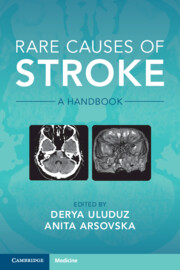Book contents
- Rare Causes of Stroke
- Rare Causes of Stroke
- Copyright page
- Contents
- Contributors
- Preface
- 1 Inflammatory Conditions
- Chapter 1.1 Isolated Vasculitis of the Central Nervous System
- Chapter 1.2 Primary Systemic Vasculitis
- Chapter 1.2 Chapter
- Chapter 1.3 Vasculitis Secondary to Systemic Disease
- 2 Infectious and Postinfectious Vasculitis
- 3 Hypercoagulable Causes of Stroke
- 4 Drug-Related Stroke
- 5 Hereditary and Genetic Causes of Stroke
- 6 Rare Causes of Cardioembolism
- 7 Vasospastic Conditions and Other Vasculopathies
- 8 Other Non-inflammatory Vasculopathies
- 9 Venous Occlusive Conditions
- 10 Bone Disorders and Stroke
- Index
- References
Chapter 1.2 - Chapter
from 1 - Inflammatory Conditions
Published online by Cambridge University Press: 06 October 2022
- Rare Causes of Stroke
- Rare Causes of Stroke
- Copyright page
- Contents
- Contributors
- Preface
- 1 Inflammatory Conditions
- Chapter 1.1 Isolated Vasculitis of the Central Nervous System
- Chapter 1.2 Primary Systemic Vasculitis
- Chapter 1.2 Chapter
- Chapter 1.3 Vasculitis Secondary to Systemic Disease
- 2 Infectious and Postinfectious Vasculitis
- 3 Hypercoagulable Causes of Stroke
- 4 Drug-Related Stroke
- 5 Hereditary and Genetic Causes of Stroke
- 6 Rare Causes of Cardioembolism
- 7 Vasospastic Conditions and Other Vasculopathies
- 8 Other Non-inflammatory Vasculopathies
- 9 Venous Occlusive Conditions
- 10 Bone Disorders and Stroke
- Index
- References
Summary
Cogan syndrome (CS) is a rare multisystem inflammatory condition characterized by ocular manifestations, classically presenting as nonsyphilitic interstitial keratitis, and audio-vestibular symptoms similar to those of Meniere’s disease. The disease evolves subacutely, with the patient typically being a young Caucasian, with no known sex predominance. Pediatric CS has also been described. The aetiology and pathogenesis of CS remain unknown, although vasculitic, infectious and autoimmune mechanisms have been proposed. The clinical signs and symptoms typically manifest as ocular and inner ear disease. Systemic manifestations present in 30%-50% of the cases, with headache, arthralgia, fever, arthritis, myalgia as the most common constitutional symptoms. Vasculitis and aortitis can also occur. Concerning neurological manifestations, the patients can present with central (stroke/ischemic events, cerebral venous thrombosis, meningitis/encephalitis) as well as peripheral nervous system (peripheral neuropathy) symptoms. Diagnosis of CS is clinical. It relies upon the presence of characteristic inflammatory eye disease and vestibulo-auditory dysfunction, with alternative causes of infection and inflammation being ruled out. The most common laboratory findings are elevated ESR and CRP, anaemia and thrombocytosis. Differential diagnosis includes sensorineural hearing loss, congenital syphilis, polyarteritis nodosa, Wegener's granulomatosis, Vogt-Koyanagi-Harada syndrome and Susac syndrome.For treatment of ocular and vestibular dysfunction, topical and systemic glucocorticoids can be used. Prognosis of CS is variable, with most patients experiencing multiple disease relapses
Keywords
- Type
- Chapter
- Information
- Rare Causes of StrokeA Handbook, pp. 60 - 65Publisher: Cambridge University PressPrint publication year: 2022

